
Jan George Bertelman (Amsterdam, January 21, 1782 - January 25, 1854), was a Dutch composer and music teacher.

Jan George Bertelman (Amsterdam, January 21, 1782 - January 25, 1854), was a Dutch composer and music teacher.
Bertelman was born in Amsterdam, Dutch Republic, in 1782. He was the son of Henry Joost Bertelman and Johanna Shock. When Bertelman was nine years old, his father died. He studied with Daniel Bracht Huyser (1769), a blind organist who worked at the Nieuwe Kerk in Amsterdam. In addition to his musical studies, Bertelman provided for his mother and himself through working other jobs. [1] In Amsterdam, Bertelman was a composer, organist and music teacher. His pupils included John Bree, Richard Hol and Hermina Maria Dijk.
Bertelman was an honorary member of four organizations: the Royal Academy of Arts, the Society for Utilities General, the Society for the Promotion of Musical Arts, and the Academy of Santa Cecilia in Rome. In 1842, he was appointed Knight of the Order of the Dutch Lion. [2]
Bertelman married Dorothea Christina Kathman in Amsterdam on April 28, 1820. He died in January 1854 at the age of 72 in Amsterdam. His son, Johannes Jacobus Bertelman, was a painter and later became the co-founder of the Museum Gouda.
Bertelman was buried in the Nieuwe Kerk in Amsterdam. In Amsterdam, Bertelmanstraat (Bertelman Street) and Bertelmanplein (Bertelman Square) are named after him.
Bertelman is regarded as a competent music theorist who contributed to the development of harmony theory for musical instruments and as one of the first Dutch composers who realized the importance of Bach. As a composer he is considered a good but conservative artist. [3]
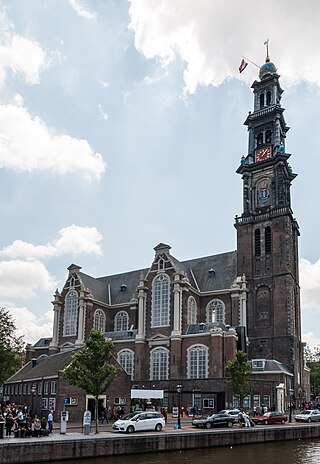
The Westerkerk is a Reformed church within Dutch Protestant Calvinism in central Amsterdam, Netherlands. It lies in the most western part of the Grachtengordel neighborhood, next to the Jordaan, between the Prinsengracht and Keizersgracht.

Jan Pieterszoon Sweelinck was a Dutch composer, organist, and pedagogue whose work straddled the end of the Renaissance and beginning of the Baroque eras. He was among the first major keyboard composers of Europe, and his work as a teacher helped establish the north German organ tradition.
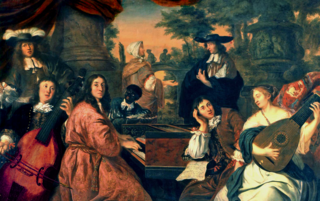
Johann Adam Reincken was a Dutch/German organist and composer. He was one of the most important composers of the 17th century, a friend of Dieterich Buxtehude and a major influence on Johann Sebastian Bach; however, very few of his works survive to this day.
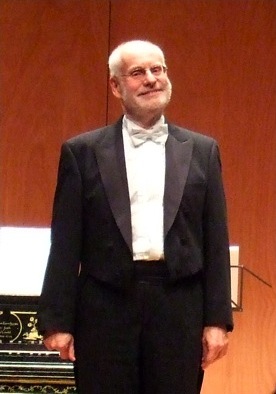
Antonius Gerhardus Michael Koopman, known professionally as Ton Koopman, is a Dutch conductor, organist, harpsichordist, and musicologist, primarily known for being the founder and director of the Amsterdam Baroque Orchestra & Choir.

The Oude Kerk is Amsterdam's oldest building and newest art institute. The building was founded about 1213 and consecrated in 1306 by the bishop of Utrecht with Saint Nicolas as its patron saint. After the Reformation in 1578, it became a Calvinist church, which it remains today. It stands in De Wallen, now Amsterdam's main red-light district. The square surrounding the church is the Oudekerksplein.
Bernardus Franciscus van Oosten is a Dutch organist, pedagogue and author. He is titular organist of the Grote Kerk in his hometown of The Hague and is an organ professor at Rotterdam Conservatoire.
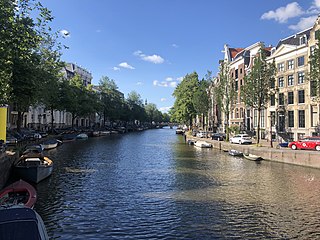
The Keizersgracht is a canal in Amsterdam, the Netherlands. It is the second of the three main Amsterdam canals that together form the Grachtengordel, or canal belt, and lies between the inner Herengracht and outer Prinsengracht.

Johannes Josephus Hermanus Verhulst was a Dutch composer and conductor. As a composer mainly of songs and as administrator of Dutch musical life, his influence during his lifetime was considerable.
Anthoni van Noordt was a Dutch composer and organist.

Johannes Bernardus van Bree was a Dutch composer, violinist and conductor.

RichardHol was a Dutch composer and conductor, based for most of his career at Utrecht. His conservative music showed the influence of Ludwig van Beethoven, Felix Mendelssohn, and Robert Schumann and the Leipzig school, though as a conductor he offered Dutch audiences the more revolutionary music of Hector Berlioz and Richard Wagner.

Felix Meritis is the name of an intellectual society in Amsterdam, but subsequently used for the building they built for themselves on the Keizersgracht.
Harry van der Kamp is a Dutch bass singer in opera and concert. Mostly active in Historically informed performance, he founded the Gesualdo Ensemble. He is also an academic voice teacher.
Pieter Bustijn was a Dutch composer, organist, harpsichordist and carillon player of the Baroque period.

Albertus Jonas Brandt was a Dutch still life painter. He was the son of a book printer and seller. While working in his father's shop, he became a pupil of J. E. Morel. After Morel's death in 1808, he spent two years with the painter G. J. J. van Os,. When van Os moved to France in 1810, Brandt taught himself, copying Jan van Huysum. In 1814 and 1816 he won prizes in the academy Felix Meritis. Soon he became famous, painting dead game, fruit, and flowers.

Adriaan de Lelie was a Dutch painter.

Gerrit Jan van Eijken was a Dutch composer. He studied first under his father, Gerrit van Eijken, who was organist and bell-ringer at the Grote Kerk in Amersfoort. His elder brother Jan Albert van Eijken was also a composer.
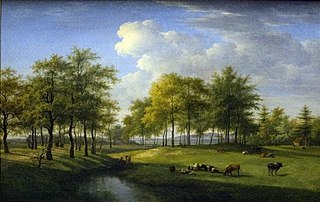
Gerrit Jan Michaëlis, was an 18th-century painter from the Northern Netherlands.

Clous van Mechelen is a Dutch musician, arranger, and actor. Van Mechelen scored a minor hit in 1969 with his band The Butlers, and became widely known through the radio and television shows written and directed by Wim T. Schippers, in which he played the character Jan Vos and wrote songs for the various characters.

Willem Hendrickszoon de Keyser was a Dutch Golden Age architect and sculptor primarily active in Amsterdam and London.
{{cite book}}: |work= ignored (help)